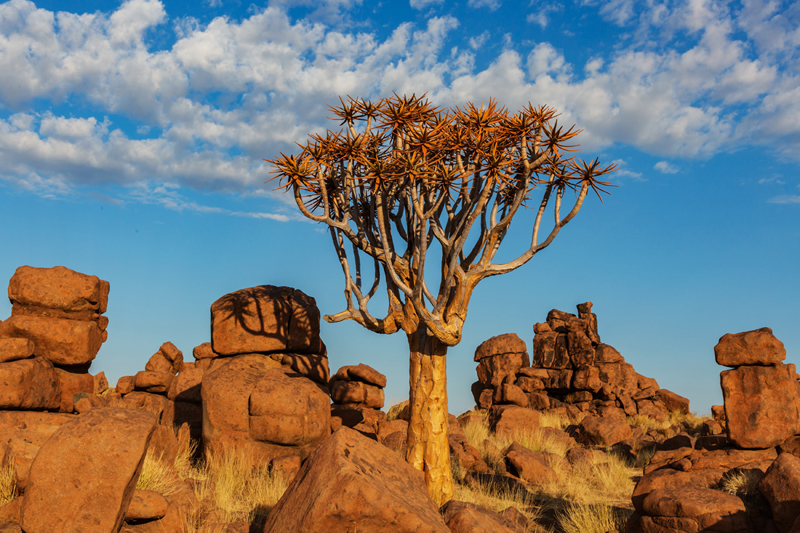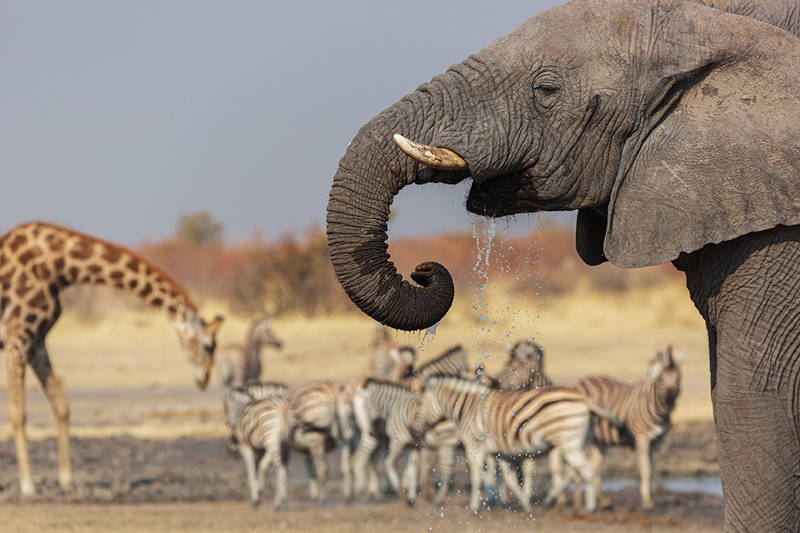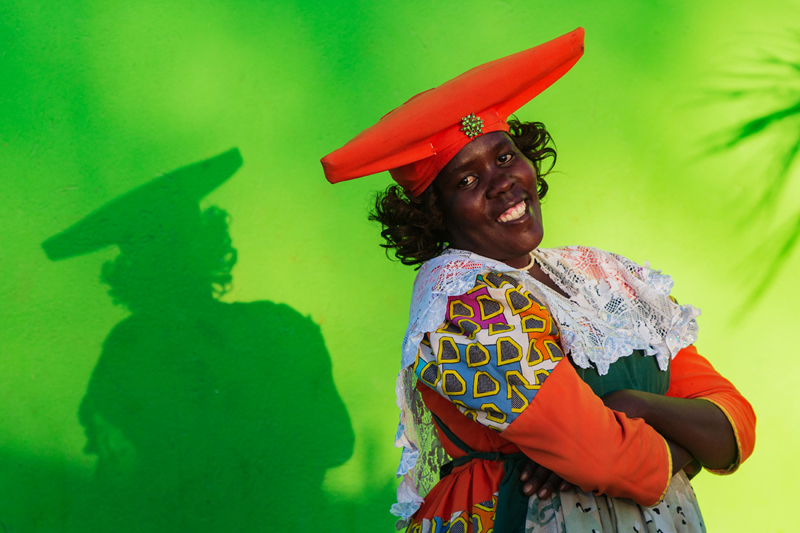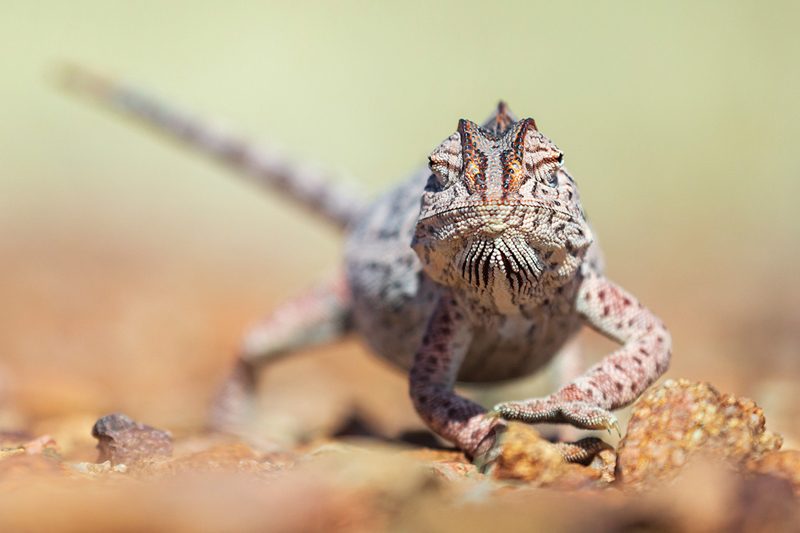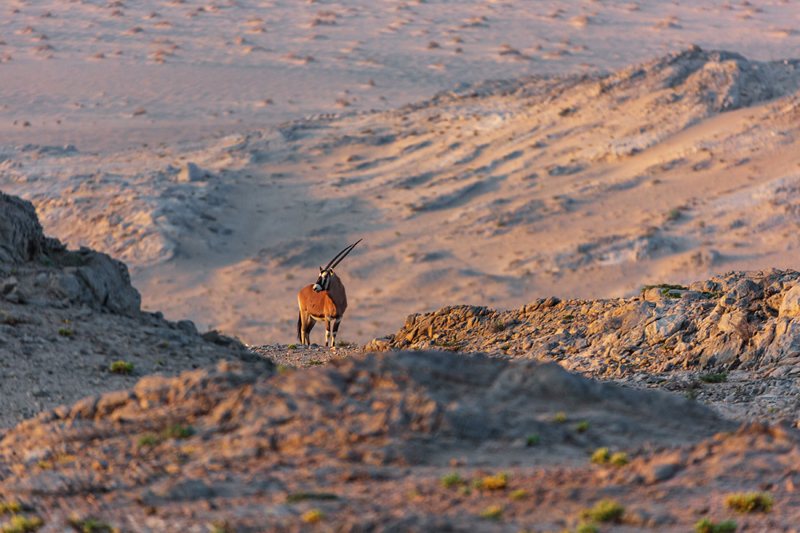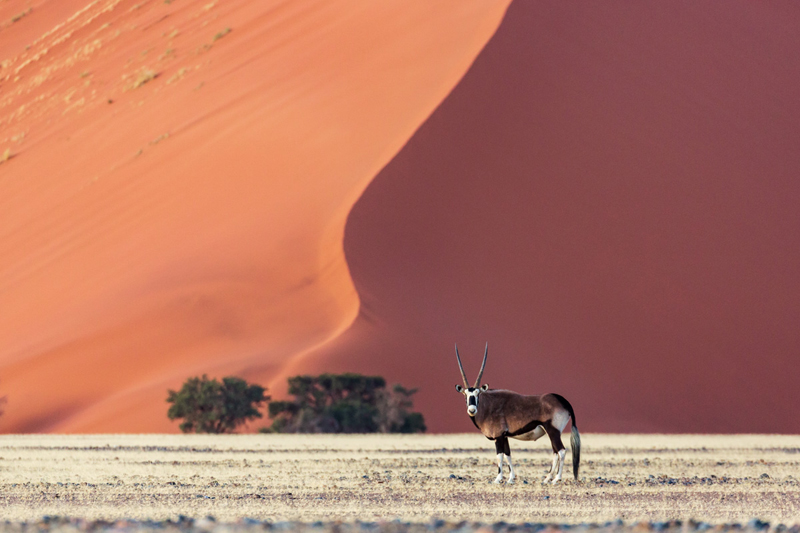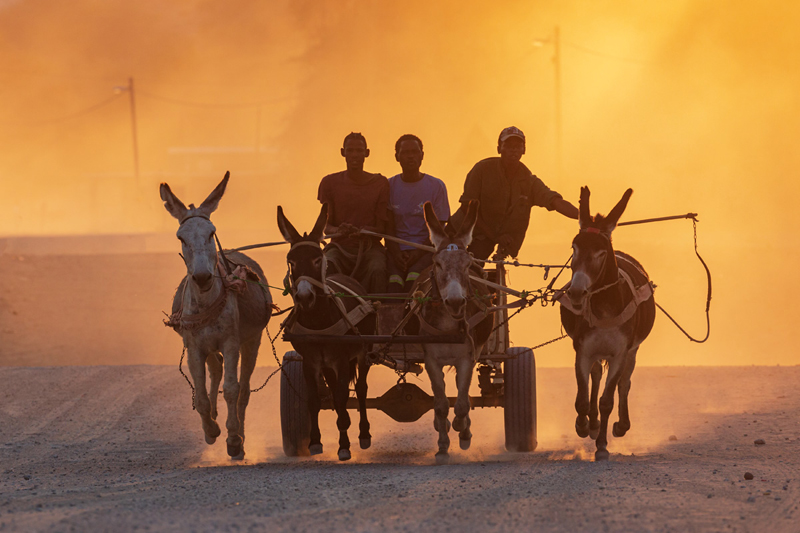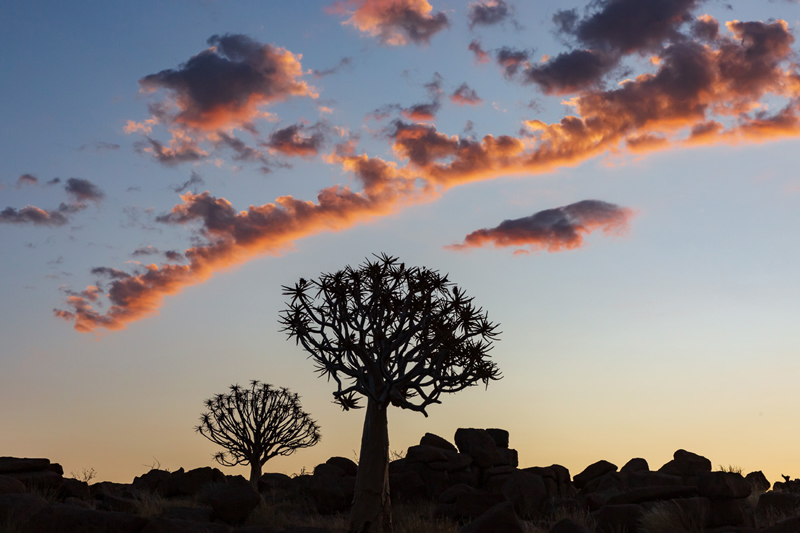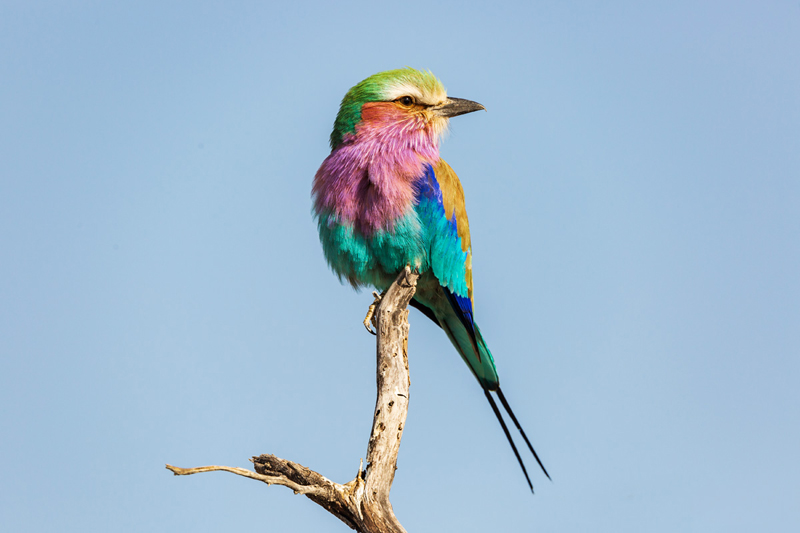Overview
Namibia is a vast country, even by African standards, covering an area approximately four times the size of the United Kingdom but with a population of a mere 2 million – one of the lowest densities in the world. It is also an ‘ageless land’; visible through our heritage of rock art created by stone-age artists and geological attractions such as the petrified forest where fossilised tree trunks have lain for over 280 million years. Added to the space and silence, these all contribute to a feeling of antiquity, solitude and wilderness.
The climate is typical of a semi-desert country. Days are warm to hot and nights are generally cool. Temperatures are modified by the high plateau in the interior and by the cold Benguela Current that runs along the Atlantic coastline. Except for the first few months of the year, the country is generally dry with very little rain. This guided Namibian safari affords you the chance to experience this magnificent and memorable country in a very personal way. You will have your own professional and experienced safari guide who will enhance your enjoyment of this unique country by making it a fascinating and stress-free journey of discovery amidst very dramatic scenery. The knowledge, experience and attitude of our guides are critical to a successful safari which is why we ensure that they are both personable and very professional.
Your safari guide will have an intimate knowledge of each area and camp/lodge that you visit, allowing them to share the local highlights whilst adding continuity and depth to your safari. It goes without saying that they know exactly what a “True African Safari” is all about. Not only are our guides highly qualified, each has a specific area of expertise. Together they possess the breadth and depth of knowledge to allow them to answer questions and satisfy the particular interests of each of our guests. Your guide will turn your safari into an experience of a lifetime!
Itinerary
Day 1: June 5 – Windhoek
On arrival in Windhoek, you will be met by your guide and transferred to our guesthouse. Overnight Villa Vista Guesthouse.
Day 2: June 6 – Windhoek | Keetmanshoop
After breakfast drive south for 499 km down the B1 highway via Rehoboth, to Keetmanshoop, arriving late afternoon. You will have a boxed lunch en route. Keetmanshoop (translates from Afrikaans as ‘the hope of Keetman’) is the administrative centre of Namibia’s largest region, Karas. It was named after the German trader Johann Keetman, who supported the mission financially. Like many missionaries of that era, they found that even though some Africans converted to Christianity, taking away their tribal beliefs was another matter.
Situated 38 km north-east of the town is the Mesosaurus and Fossil and Quiver Tree (Kokerboom) Dolerite Park, set in an area that includes the Mesosaurus Fossil Site and the Quiver Tree Forest and eroded dolerite rock formations.
Here you will be able to photograph the quiver tree (Kokerboom) forest scenery in pretty afternoon light. Overnight Maritz Country Lodge.
Day 3: June 7 – Keetmanshoop
We will spend the whole day photographing at the quiver tree forest and the Giant’s Playground. In the evening, we will spend some time doing astrophotography. The night sky is one of the clearest, least light-polluted in the world—there will be no moon. Overnight Maritz Country Lodge.
Day 4, 5: June 8 – 9 – Keetmanshoop | Kolmanskop | Lüderitz
After breakfast and a morning shoot at the Kokerboom forest, we depart along the B4 highway west to Lüderitz, for 356 km. En route there are spectacular views of boulder-strewn hillsides across wide open plains. You will have a picnic lunch en route.
The following morning, we drive to the nearby “ghost town” of Kolmanskop where we will photograph until lunchtime. After lunch, we will drive out into the restricted area to the mining town of Elizabeth Bay. Though it often seems to be forgotten in the shadow of its ghost town counterpart, Kolmanskop, Elizabeth Bay was another lucrative diamond mining town that is worth exploring (if there are entry restrictions, we will make alternative plans and visit Diaz Point, a rocky, wind-buffeted outcrop known for its seabirds and seals). Overnight in Lüderitz Nest Hotel.
Day 6, 7, 8: June 10-12 – Lüderitz | Sesriem
After breakfast, depart for Sesriem along the scenic D707 route with a picnic lunch en route. The drive is 470 km. The route passes through the Namib Naukluft National Park with spectacular plains and mountain scenery and there is plenty of opportunity to stop and photograph en route. Arrive at Namib Desert Lodge in the evening.
One of the most enduring impressions of the Sossusvlei area is the early morning light on the sea of vivid orange dunes, some as high as 984 feet. Nearby world-famous Sossusvlei is an enormous clay pan, flanked by the famous red dunes that stand out starkly against the blue sky.
These dunes – the most well-known being Big Daddy or Dune 45 – have developed over millions of years, the wind continuously refashioning the contours of this red sand sea. The ‘vlei’ itself only fills after rare heavy rainfall when, in a complete turnaround, it transforms into a spectacular inland lake.
Photography of the dunes in the early morning and late afternoon is particularly stunning with rich reds and dark shadows completing the extraordinary vista that is the enormity of the Namib Desert. Overnight Namib Desert Lodge.
Day 9: June 13 – Sesriem | Walvis Bay
After an early breakfast, we’ll drive across the desert to Walvis Bay. Overnight Oysterbox Guesthouse.
Day 10: June 14 – Sandwich Harbor
The Turnstone Tour to Sandwich Harbor begins when you are collected from your hotel at about 08h45. You drive along a beautiful dune chain, adjacent to the Atlantic Ocean, zigzagging the original railway line between Swakopmund and Walvis Bay. This is an opportunity for a detailed look at the formation of ‘the world’s oldest desert’ – its origins, composition, and movements.
Your first stop is at ‘Bird Rock’ – a guano island inhabited by 200,000 birds and one of the first examples of man’s efforts to utilize the rich natural resources of the area.
The Lagoons at Walvis Bay and at Sandwich Harbor have been designated as ‘Wetlands of International Importance’, while the ‘Bird Paradise’ at Walvis Bay is also a key nesting and feeding site for thousands of visiting and resident birds. A recent bird survey, overseen by expert ornithologists from Namibia and South Africa, counted record numbers of Flamingo, Plover, and Tern between Walvis Bay Lagoon and Sandwich Harbor. Other favorites, such as Pelican, Avocet, Turnstone, and a huge variety of waders can be seen, with numbers peaking at around 170,000 in November. Several endemic species, such as the Dune Lark and the Damara Tern, are also found in the vicinity.
Leaving Walvis Bay behind, you head for the lower reaches of the Kuiseb Delta. This unique ecosystem is dotted with archaeological sites, 450 year-old animal tracks, windblown graves and magnificent dunes. There is evidence of ancient and recent gathering, harvesting and trading by the Topnaar, an indigenous Namibian community descended from the !Khoi group, which relies on the naturally occurring Nara fruit for survival.
Turning south, you begin the approach to Sandwich Harbor. This crosses barren salt pans and vegetation-covered hummock dunes, which shelter small groups of Springbok, Ostrich, Jackal, and Brown Hyena. Peregrine Falcons, Pale Chanting Goshawks, and Black-breasted Snake Eagles can sometimes be seen hunting small mammals (such as gerbils, three-striped mice, and Cape Foxes) which share the dunes with a fascinating variety of desert-adapted insects, reptiles, and plants.
This section of the journey is as dramatic as the landscape, and it soon becomes clear why Sandwich Harbor is often described as inaccessible! Spring tides and shifting sands ensure an unpredictable route, but as you approach the towering, wind-sculptured dunes at the edge of Sandwich Harbor, there is a sense of entering a different world. All that is left of the old whaling station and its community of traders and fishermen is the freshwater lagoon, a solitary deserted building, and the strange greenery of this unique coastal wetland. This is the setting for your picnic – a large hamper full of homemade cakes, savories, salads, fruit, and drinks – and a spot of bird-watching. Recent surveys recorded some 40,000 birds – 34 different species – in this area. Take a leisurely walk around the Lagoon (an official marine sanctuary) and you may also see seals, dolphins, and even whales.
The drive back home affords a last look at these haunting landscapes and a chance for reflection…you will arrive back at your hotel about 17h00. Overnight in Oysterbox Guesthouse.
Day 11: June 15 – Walvis Bay | Hobatera Lodge
Today is the longest drive of the tour. Leaving at the crack of dawn with a box breakfast, we will drive north up the Skeleton Coast. Passing through Swakopmund our first stop will be to photograph the Zeila Shipwreck. This fishing trawler, sold as scrap metal to an Indian company by Hangana Fishing of Walvis Bay, got stranded on 25 August 2008 after it came loose from its towing line while on its way to Bombay shortly after it left Walvis Bay.
Before we turn inland at Torra Bay, our next stop is the Cape Cross Seal Reserve, the best-known breeding colony of Cape fur seals along the Namib coast. The population has grown large and fat by taking advantage of the rich concentrations of fish in the cold Benguela Current, and the sight of more than 100,000 seals basking on the beach and frolicking in the surf is impressive to behold – you will however, have to contend with the pong.
You will have a packed lunch en-route. We will arrive at Hobatere Lodge by late afternoon. Overnight Hobatere Lodge.
The Hobatera Lodge is situated in a concession area of 8,808 hectares and is home to a rich diversity of game, including elephants and lions. With conservation in mind, the lodge actively promotes the peaceful co-existence of man and nature. Thatched roofs keep the well-appointed chalets cool and offer shade against the heat of the African savannah. A dip in the pool refreshes after a day of game viewing. The friendly staff prepares delicious meals.
Day 12: June 16 – Hobatere Lodge
Hobatere Lodge’s guests have access to western Etosha through Galton Gate. Overnight Hobatera Lodge.
Etosha National Park
Etosha National Park, translated as the ‘Place of Mirages’, Land of Dry Water’ or the ‘Great White Place’, covers 22,270 km², of which over 5,000 km² is made up of saline depressions or ‘pans’. The largest of these pans, the Etosha Pan, can be classified as a saline desert in its own right. The Etosha Pan lies in the Owambo Basin, on the north-western edge of the Namibian Kalahari Desert. Until three million years ago it formed part of a huge, shallow lake that was reduced to a complex of salt pans when the major river that fed it, the Kunene, changed course and began to flow to the Atlantic instead. If the lake existed today, it would be the third largest in the world. Etosha Pan is the largest of the pans at 4,760 km² in extent. It is nowadays filled with water only when sufficient rain falls to the north in Angola, inducing floods to flow southward along the Cuvelai drainage system. The Park consists of grassland, woodland, and savannah. Game-viewing centers around the numerous springs and waterholes where several different species can often be seen at one time. The Park boasts some 114 mammals and over 340 bird species. Wildlife that one might see includes elephant, lion, giraffe, blue wildebeest, eland, kudu, gemsbok (oryx), zebra, rhino, cheetah, leopard, hyena, honey badger, and warthog, as well as the endemic, black-faced impala.
Day 13: June 17 – Hobatere Lodge | Dolomite Camp
Etosha’s new and exclusive Dolomite Camp opens up the restricted western side of the park to a limited number of visitors. Guests are accommodated in permanent luxury tents with an elevated view of the endless plains of Etosha National Park in Namibia. The wildlife has developed without human disturbance and rare species such as black rhino and black-faced impala have established themselves in the area. The area is rich in waterholes that attract elephant, rhino, leopard, lion, springbok, gemsbok and red hartebeest. The birdlife is prolific, and the seasonal flowers of Dolomite Hill are a highlight for botanists.
Dolomite’s guests have access to western Etosha trough Galton Gate. Perched on the top of a little hill Dolomite Camp offers a sublime view to complement the luxuriously appointed camp. The camp is unfenced allowing animals to roam freely between the tents and communal area. However, with personal escorts, your safety is guaranteed at all times. The restaurant serves delicious and satisfying meals and the personnel will always greet you with a smile. A rim flow swimming pool, a curio shop and a viewing deck overlooking a prolific waterhole provide entertainment during the day, while the bar area is ideal to relax and socialize with other guests. Overnight Dolomite Camp.
Day 14: June 18 – Dolomite Camp | Namutoni Camp, Etosha
Built into an old German Fort Namutoni Camp has a unique atmosphere. Within the fort you will find ample facilities and a variety of accommodation. From the walls of the fort you can enjoy an elevated view of the King Nehale Waterhole allowing for great game viewing without leaving the camp. The walls of the fort are also and excellent spot for sundowners. There is hardly a better way to end a day in the bush and Namibia than to marvel at the colours of the setting sun.
The Camp is situated in the eastern part of Etosha National Park and is accessible via the Von Lindequist Gate. Its close proximity to Fisher’s Pan makes Namutoni a hotspot for birders. Two restaurants, a craft shop, a pool, and a viewing deck overlooking King Nehale Waterhole make the fort a great place to relax at lunchtime or after evening game drives. The African Fusion restaurant will introduce you to local flavours, while The Steakhouse offers popular western dishes. A superette, curio shop, and petrol station allow you to stock up on everything necessary and nice.
Namutoni was originally established as a control post during the mad cow disease (BSE) epidemic of 1897 in Namibia. The fort was built be the German Schutztruppe from 1902-03 and rebuilt in 1906 after the Ovambo destroyed the original building. The fort served as a police post and later as a South African army base. Fort Namutoni was declared a national monument in 1950 and was opened to tourism in 1957. Overnight Namutoni.
Day 15: June 19 – Namutoni Camp | Okonjima Africa Foundation
After our wildlife-filled adventure in Etosha National Park, the penultimate day will be spent driving south toward Windhoek. En-route we will spend our last night at Okonjima. Overnight Okonjima Africa Foundation Plains Camp.
Okonjima Nature Reserve is equally famed for frequent leopard, brown hyaena, and pangolin sightings on its safaris, as well as The AfriCat Foundation. Since being founded in 1991, AfriCat’s mission has been to make significant contributions to conservation, while trying to ensure the survival of Namibia’s predators in their natural habitat. It undertakes research and environmental education projects. Plains Camp honours the Hanssen’s family cattle-farming heritage with its three-tier accommodation facility of 10 spacious View Rooms, 14 spacious Classic Rooms.
Day 14: June 20 – Transfer to the Airport
After a hearty breakfast, we will transfer to the Hosea Kutako International Airport at Windhoek for your flight back home.

